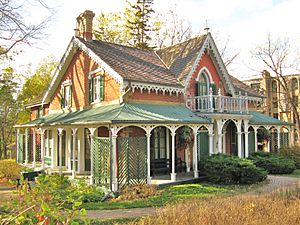Hillary House and Koffler Museum of Medicine facts for kids
Hillary House, the Koffler Museum of Medicine, is a historic house in Aurora, Ontario. It was built in 1862 and is a great example of the Gothic Revival style. This style was popular in the 1800s and looked back to the grand buildings of the Middle Ages.
Hillary House is recognized as a special Canadian heritage site. Today, it is a museum filled with old medical tools, books, and furniture from the 1800s and 1900s. The Aurora Historical Society has owned the house since 1981. It is open to visitors as Hillary House, the Koffler Museum of Medicine.
Contents
A Home for Doctors
For many years, Hillary House was home to doctors and their families. These doctors also ran their medical practices right from the house! They had a special room for preparing medicines and another for seeing patients.
Doctors in those days often traveled by horse and buggy to visit sick people in Aurora and nearby areas. Each doctor became a very important part of the community. The Hillary family, who were doctors, lived in the house for over 100 years.
Doctors Who Lived Here
Here are the doctors who called Hillary House home:
- 1862 – 1869: Dr. Water Bayne Geikie built Hillary House. He was born in Scotland in 1830. He lived there with his wife, Miriam Woodhouse, and their four children.
- 1869 – 1876: Dr. Frederick William Strange moved in. He was a surgeon in the Royal Regiment of Canadian Infantry. He lived with his wife, Esther Rose, and their daughter.
- 1876 – 1894: Dr. Robert William Hillary took over the house. He was born in Ireland in 1832. He lived there with his wife, Annie Fry, and their seven children.
- 1894: Robert Michael Hillary, one of Robert William's sons, bought the house. He married Edith Mussen in 1895. They lived in the house with their nine children.
- Nora Hillary, a daughter of Robert Michael, lived in the house until 1993.
Gothic Revival Style
In the 1700s, people in Britain became very interested in the Middle Ages. This led to a new style of building called Gothic Revival. It soon came to Canada in the early 1800s.
As the style became popular, builders started to try new ideas with it. Gothic Revival buildings appeared all over Canada. You could see them as government buildings, churches, and even homes like Hillary House. This style became a part of Canadian building history.
Special Features of Hillary House
Hillary House was finished in 1862 and shows many features of the Gothic Revival style. These include:
- Tall and Pointy Shapes: The house looks very tall and has a strong vertical design.
- Fancy Decorations: You can see detailed carvings on the gables (the triangular parts of the roof) and bargeboards (the decorated boards along the edge of the roof).
- Trefoil Shapes: These are decorations shaped like a three-leaf clover, a classic Gothic design.
- Pointed Windows and Doors: The windows and door frames have a tall, pointed arch shape.
You can find these special features both outside and inside the house. They appear on staircases, wall panels, and more. Because of its unique architecture, Hillary House was named a National Historic Site in 1971.
Museum Collections
Hillary House is now a museum that helps us learn about medicine and life in the past. It has many interesting items from the 1800s and 1900s. You can see old medical tools that doctors used, like surgical instruments and medicine bottles. The museum also has old books, letters, and papers that tell stories about the doctors and their families. You can also see furniture and household items that show how people lived in the house long ago.
See also


